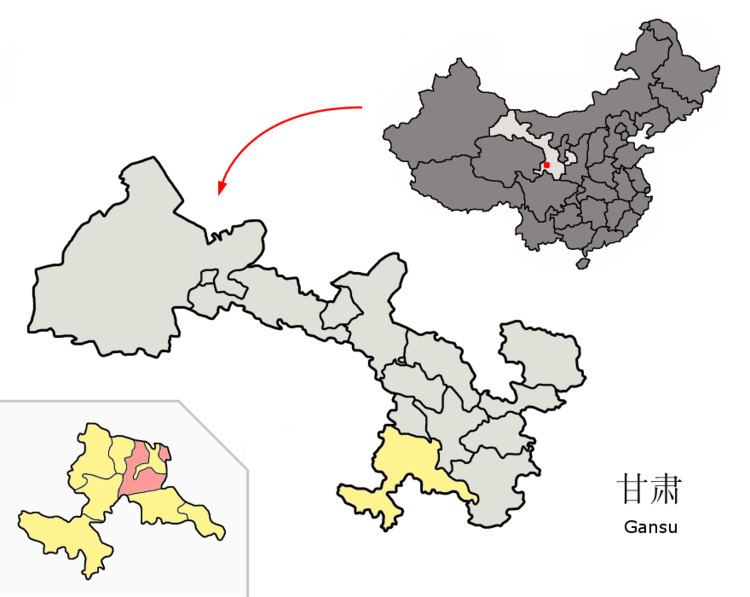Area 5,694 km² Province Gansu | Local time Tuesday 2:58 AM | |
 | ||
Weather -8°C, Wind SW at 6 km/h, 97% Humidity Points of interest Yeliguan National Forest Park, Guanggaishan, Xiangqing Happy Farmhouse | ||
Jonê County (also Cone, Chone, Choni; Tibetan: ཅོ་ནེ་རྫོང་།, Wylie: co-ne rdzong; local pronunciation: /tɕɔᴸnɛ/[1]; Chinese: 卓尼县; pinyin: Zhuōní Xiàn) is an administrative district in the Gannan Tibetan Autonomous Prefecture, Gansu Province, China. It is one of 58 counties of Gansu. It is part of the Gannan Prefecture. Its postal code is 747600. Its area is 4,954 km2, and its population is over 100,000 people. It is administered from Jonê Town.
Contents
Map of Jone, Gannan, Gansu, China
Description
The county covers both banks of the middle section of the Lu-chu. The country town and adjacent Jonê Monastery are on the north bank. The side valleys on the southern side used to be branches of the ancient kingdom of Jonê.
History
"There are traditions of Tibetan soldiers left behind [after the late 10th century] at several border outposts, such as Jonê, where they established viable settlements, and of the remaining Tibetan conscript troops, called the Wun Mo, carving out considerable territory for themselves until they were perhaps absorbed into that amalgam of people of Tibetan stock, which came to form the Hsi Hsia Kingdom (982—1224)."Jonê was part of a separate kingdom formed, according to legend, after its invasion by warriors who migrated across the mountains from Szechuan conquering the local tribes in 1404. The contemporary descendants of the Jonê royal line claim that their line is Tibetan, and that their ancestors migrated from central Tibet through Sichuan.
The Yongle Emperor (May 2, 1360 – August 12, 1424) named one of these invading warriors hereditary chief (tusi), bestowing the family name of "Yang" ("杨") and an imperial seal upon his line. The Jonê king (co-ne rgyal-po) established a palace on the north bank of the Tao River. The family holding the Yang seal continued to rule over 48 Tibetan clans in Jonê as an autonomous kingdom from the early 15th century for 23 generations, until 1928, when it was placed under the control of the Lanchow government. In the late Qing Dynasty and Republican Period, many nomadic regions had considerable de facto independence, despite the claims and perspective of the Chinese rulers.
Among the six monasteries in the county, all of them Tibetan Geluk establishments, is the great Jonê Monastery.
The American botanist Joseph Rock spent almost 2 years in Jonê ("Choni", in his spelling) in 1925-26. He resided in the compound of the local chief (the 19th-generation tusi Yang Jiqing (杨积庆)), making it the base for his exploration of southern Gansu and eastern Qinghai. His account of the culture of this "almost unknown Tibetan principality", as he described it, illustrated with color photographs, was published in the National Geographic.
As of 2012, Jonê was apparently closed to foreign visitors.
